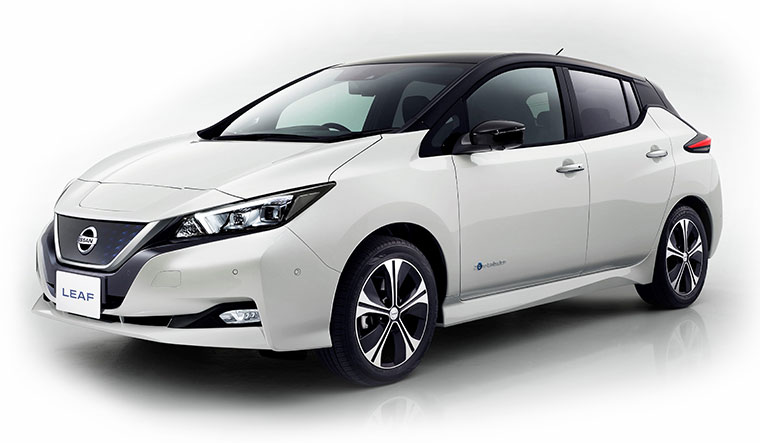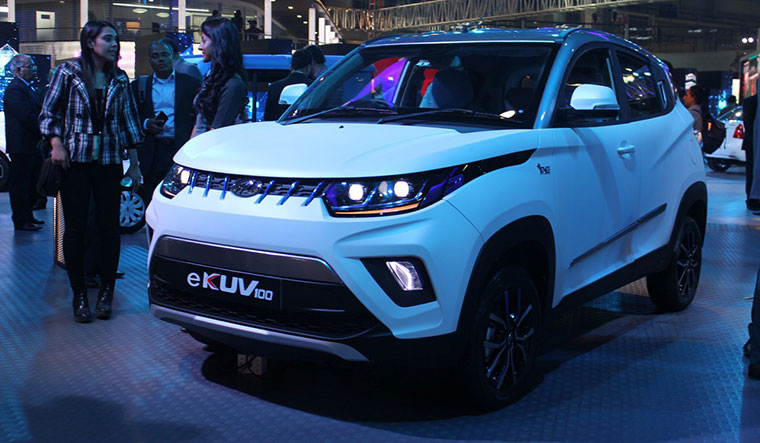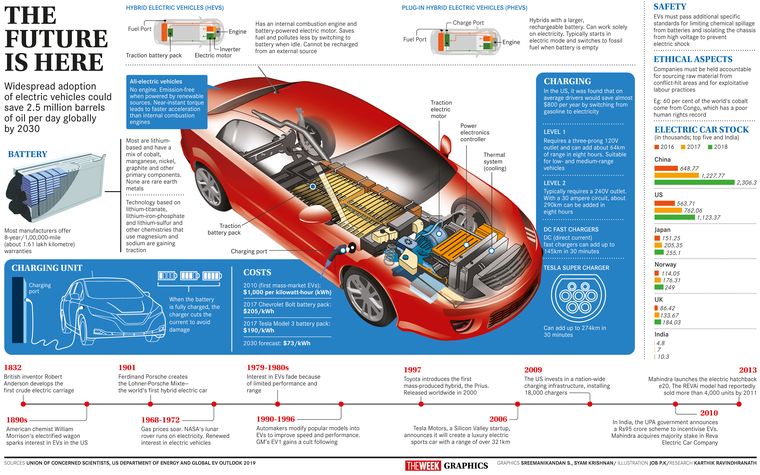Range anxiety.
Coined by a business journal in the late 1990s, it refers to drivers’ fear of electric vehicles (EVs) running out of charge before reaching the destination or a charging station. In Norway, which has a high number of private EVs, the local language equivalent even made it to the final list of ‘word of the year’ a few years ago.
For better or worse, you will hear this term bandied about a lot, as India’s thus-far amorphous ‘electric dream’ now has a solid direction and focus. While Narendra Modi had consistently plugged EVs from the time he became prime minister, it remained mostly lip-service during his first tenure. A dramatic change came a few months ago, when the government’s policy think-tank, NITI Aayog, came up with an ambitious timeline for India to go electric—only EV three-wheelers to be sold from 2023, all two-wheelers up to 150cc (which constitutes the vast majority) by 2025 and a percentile-based roadmap for cab aggregators like Ola and Uber to convert their fleet to electric, starting at 2.5 per cent soon and going up to 40 per cent by 2026. And the final deadline—only electric vehicles to be sold in the country by 2030.
“We aim to leapfrog and envision India as a global hub of electric vehicles,” declared finance minister Nirmala Sitharaman on July 5, as she pulled out a range of goodies for the sector out of her budget. This included income tax deductions up to Rs2.5 lakh on interest on EV loans and import duty cuts on components required for making electric vehicles and their batteries. Earlier the government had announced sops like free vehicle registration and the second instalment of FAME, or the Faster Adoption and Manufacturing of (Hybrid and) Electric-vehicles scheme, which offers Rs10,000 crore worth of subsidies to EV manufacturers. Another boost came in the form of the Goods and Services Tax Council reducing the tax on EVs from 12 per cent to 5 per cent.
Since then, the government seems to have decided to go slow on phasing out internal combustion engine vehicles after the distress signals from the automobile industry. On August 23, Sitharaman announced that BS-IV vehicles purchased up to March 2020 will remain operational for the entire period of registration. She also lifted a ban on purchase of vehicles by government departments and allowed an additional 15 per cent depreciation on vehicles acquired till March 2020. Union Road Transport Minister Nitin Gadkari also clarified that the government was not following up on deadlines to phase out motor vehicles in favour of EVs. “Such conversions will happen in its natural course,” the minister told THE WEEK.
These measures, however, are unlikely to dampen the buzz about EVs. “The economic support from the government will help fast-track some exceptional future products (as they will become) reasonably affordable,” said Parveen Kharb, CEO and cofounder of 22 KYMCO, a Gurugram-based joint venture with a Taiwanese company, which focuses on electric two-wheelers.
Things are looking up on the production side as well. Just a few days after the budget, Hyundai launched the Kona, a fully electric SUV that can go 452km on a single charge (full charging takes less than two hours on a quick charger). Sure, at Rs23 lakh it is not a steal, but as the first full-fledged electric car available in the Indian market for the individual buyer, it is significant. Mahindra’s eVerito and Tata’s Tigor EV are available only for institutional sales to government bodies or fleet aggregators, and Mahindra e2o, originally Reva, was rather experimental in nature.
Luxury car manufacturers Jaguar, Audi and BMW are planning on bringing in their electrics to the Indian market over the next few months. Jaguar’s first electric car, the I-Pace, is the World Car of the Year 2019. And Elon Musk tweeted in November 2018 that his Tesla would start operations in India by the end of 2019.
Such big-ticket announcements apart, the high voltage jolt that will mainstream this sector would be the launch of an affordable electric car. Nissan’s Leaf, the largest selling electric car in the world and also a hatchback, is slated to go on sale in India by the end of this year. But its cost could be on the higher side, like the Kona, as it will not be manufactured locally.
That is where Maruti Suzuki comes in. India’s biggest carmaker has been spotted testing the electric variant of its Wagon R on the streets of Gurugram. A roll-out of its first electric model (either the Wagon R or a variant of the Ertiga) is expected next year. Tata will also enter the fray with its first electric car for private users, the Tata Altroz, a hatchback. “We intend to take lead by developing high-quality products that are exciting and accessible for the Indian consumer, focus on key micro-markets to build an EV ecosystem in order to overcome the mental barriers of consumers toward EV,” said Shailesh Chandra, president, electric mobility, Tata Motors.
An electric SUV from Morris Garages (MG) and Mahindra’s eKUV 100 hatchback could arrive before the Altroz. “We have a plant coming up in Chakan, where we will make motor, battery, electronics and transmission,” said Pawan Kumar Goenka, managing director, Mahindra.
Interestingly, the two-wheeler segment is miles ahead in the electric sweepstakes, with both conventional makers and startups launching models. “Electric two-wheeler industry is almost 12 years old in India, though the initial players launched only slow-speed models like electric cycles, since they did not need licence or registration,” said Jeetender Sharma, founder and managing director of the startup Okinawa Autotech, which has six electric scooters in the market. “But now technology has changed.”
Other players in the market include Ather (which has investors like Hero MotoCorp and Flipkart cofounder Sachin Bansal) and Micromax founder Rahul Sharma, who launched India’s first electric motorcycle, the Revolt RV 400, last fortnight. “I could see both the worlds merge,” said Sharma, explaining his shift from mobiles to mobility. “The electro-mechano space coupled with seamless telematics and data in favour of the consumers. Just the thought got me thinking hard.”
Unlike the conventional internal combustion engine (ICE) vehicles, the battery is at the heart of EVs. Despite the government cutting import duties on EV components, battery availability and cost remain a concern in India. With no standardisation, there are multiple technologies and business models at play, further confusing the customer. For example, Okinawa scooters come with batteries that can be charged on the go or removed and charged on a regular power socket, while Ather has gone for a ‘grid’ of charging stations in Bengaluru and Chennai. “To reduce range anxiety, we have set up a public charging network where each point is not more than 4km from any other point in the city,” said Tarun Mehta, CEO and cofounder of Ather, which plans to expand to 6,500 charging points across 30 cities in four years.
Despite the ambitious plans to ramp up the charging infrastructure, it remains a point of worry. Though the ministry for heavy industries has invited proposals from the government, civic bodies and private firms for setting up EV charging infrastructure, charging points are stuck in a chicken-and-egg situation. Lack of standardisation is a big issue, with different vehicles, from buses to two-wheelers, from different entities following different technologies and models. For instance, none of the EVs currently available in the country, except the Kona, can utilise charging stations set up as per the power ministry’s guidelines and standards. “While policies are in the right direction, we have to realise that one size does not fit all,” said Kharb of 22 KYMCO. “A serious strategy to standardise EV batteries must be devised.”
Many experts say battery swapping is an effective solution. “Our learning has showed us that adopting a battery swapping model for two- and three-wheelers will reduce the wait time for charging and increase flexibility in operation,” said Anand Shah, cofounder of Ola Electric. Ola is running pilot projects in Nagpur and Gurugram, aiming at rolling out 10,000 electric three- and two-wheelers this year. “Ola feels EV will be a better option than ICE both for the end user and the environment,” he said.
That is not exactly music to the ears of many automakers who had added huge capacities in the past few years. Already reeling under a decline in sales and the pressure to shift to the to BS VI emission norms, they are worried by the government’s push for electrification. “To force an unrealistic deadline for mass adoption of electric two- and three-wheelers will not just create consumer discontent, it risks derailing auto manufacturing in India that supports four million jobs,” said Venu Srinivasan, chairman, TVS Motors.
Automakers were particularly incensed at the proposal to ban ICE vehicles. “We are not saying it is not possible,” said Rajan Wadhera, president of the Society of Indian Automobile Manufacturers (SIAM). “It is possible and we are part of that plan as a signed body. The issue is only about the timeline.” SIAM’s proposal is to keep 2047, the centennial of Indian independence, as the deadline to go 100 per cent electric. “ICE auto industry is the pillar of the economy and we cannot let that fall,” said Goenka of Mahindra. “So, both have to coexist for a while. We should move aggressively towards EV, but not at the cost of destroying ICE vehicles.”
So the question boils down to whether one should go for an EV or wait for the policies to be clear? There are still no value-for-money electric cars with specs and prices matching those of ICE cars in the market, but that may not be the case a few months down the line.
But when it comes to two-wheelers, it is a different story altogether, with a plethora of models with various charging options and affordable price tags available right now. While these scooters are good for the daily commute, long drives may still need to wait, considering the range limitations. Chances are that you are more likely to ride a public transport EV like a bus or a cab, before you go in to buy one of your own.
“Factors like crude import dependance and pollution make us move in favour of EVs,” said G.D. Lohani, joint secretary, ministry of finance. “In the days to come, the way we are going and the way charging infrastructure is being invested into, the way concessions are being provided and the conscious movement forward in terms of the policy narrative, electric vehicles are the way forward.”
—With Nachiket Kelkar







